
Kilbrogan House is an early 19th century Georgian house situated in Bandon in County Cork, Ireland. The house was built in 1818 on Kilbrogan Hill near the centre of Bandon.

Kilbrogan House is an early 19th century Georgian house situated in Bandon in County Cork, Ireland. The house was built in 1818 on Kilbrogan Hill near the centre of Bandon.

Kilbrogan House was built in 1818 on the Bandon estate of William Cavendish, 6th Duke of Devonshire. [1] Remaining original features include ornate plaster work and exterior limestone steps. [1]
Originally owned by the Devonshire estate and let to several tenants, in the 1890s the freehold was sold to Richard Wheeler Doherty.[ citation needed ] Doherty leased the house to Joseph Brennan, whose business interests included a local bakery, brewery, flour mill and an electric company which supplied electricity to Bandon from 1919 to 1939. [1] In October 1920, during the Irish War of Independence, much of Bandon (including Brennan's businesses and Kilbrogan House) was attacked by British soldiers as part of a series of indiscriminate reprisals following an IRA ambush at Ballinhassig. [2] [3] Joseph Brennan's son, also named Joseph Brennan and also associated with the house, was governor of the Central Bank of Ireland from 1943 to 1953. [1] [4]
The house changed hands several times, [1] until the then owner renovated it in the 1990s. [5] Operated as a bed and breakfast for several years, [5] as of mid-2021 it was "no longer in operation" as accommodation. [6]

The Irish War of Independence or Anglo-Irish War was a guerrilla war fought in Ireland from 1919 to 1921 between the Irish Republican Army and British forces: the British Army, along with the quasi-military Royal Irish Constabulary (RIC) and its paramilitary forces the Auxiliaries and Ulster Special Constabulary (USC). It was part of the Irish revolutionary period.

The Auxiliary Division of the Royal Irish Constabulary (ADRIC), generally known as the Auxiliaries or Auxies, was a paramilitary unit of the Royal Irish Constabulary (RIC) during the Irish War of Independence. It was founded in July 1920 by Major-General Henry Hugh Tudor and made up of former British Army officers, most of whom came from Great Britain and had fought in the First World War. Almost 2,300 served in the unit during the conflict. Its role was to conduct counter-insurgency operations against the Irish Republican Army (IRA), acting mainly as a mobile striking and raiding force. It operated semi-independently of the RIC and was mainly deployed to southern and western regions where fighting was heaviest.
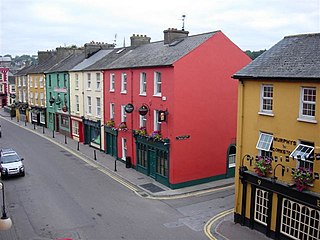
Bandon is a town in County Cork, Ireland. It lies on the River Bandon between two hills. The name in Irish means 'Bridge of the Bandon', a reference to the origin of the town as a crossing point on the river. In 2004 Bandon celebrated its quatercentenary. The town, sometimes called the Gateway to West Cork, had a population of 8,196 at the 2022 census. Bandon is in the Cork South-West constituency, which has three seats.
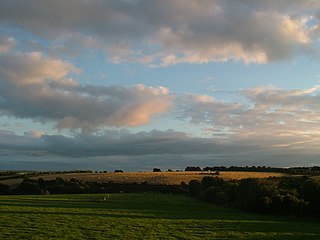
Ballinhassig is a village in County Cork, Ireland, situated 10.6 km (6.6 mi) south of Cork City just off the N71 Bandon road and near the source of the River Owenabue.
Events from the year 1920 in Ireland.

Thomas Bernardine Barry, better known as Tom Barry, was a prominent guerrilla leader in the Irish Republican Army (IRA) during the Irish War of Independence and the Irish Civil War. He is best remembered for orchestrating the Kilmichael ambush, in which he and his column wiped out a 18-man patrol of Auxiliaries, killing sixteen men.
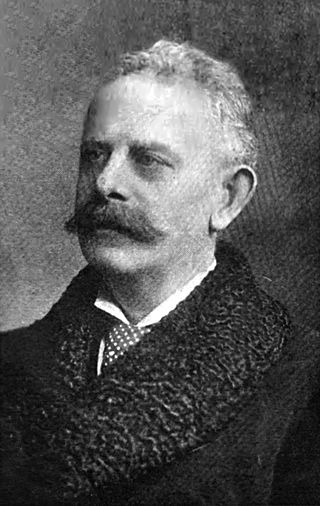
James Francis Bernard, 4th Earl of Bandon, KP, was a British Deputy Lieutenant in Ireland and Irish representative peer. Bernard was a cousin of the Earl of Midleton, who was head of the southern Irish Unionist Alliance at the time of the Anglo-Irish War, 1919–21.

Thomas Hales was an Irish Republican Army (IRA) volunteer and politician from West Cork.
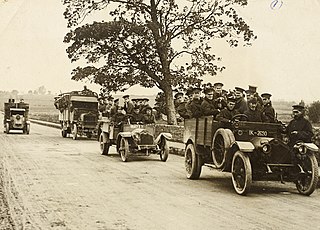
This is a timeline of the Irish War of Independence of 1919–21. The Irish War of Independence was a guerrilla conflict and most of the fighting was conducted on a small scale by the standards of conventional warfare.

Cork, located on Ireland's south coast, is the second largest city within the Republic of Ireland after Dublin and the third largest on the island of Ireland after Dublin and Belfast. Cork City is the largest city in the province of Munster. Its history dates back to the sixth century.
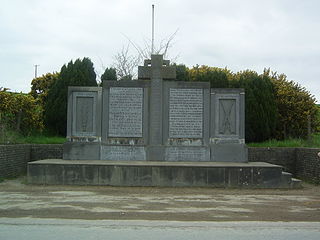
The Crossbarry ambush or Battle of Crossbarry occurred on 19 March 1921 and was one of the largest engagements of the Irish War of Independence. It took place near the small village of Crossbarry in County Cork, about 20 km south-west of Cork city. About a hundred Irish Republican Army (IRA) volunteers, commanded by Tom Barry, escaped an attempt by about 1,200 British troops to encircle them. During the hour-long battle, ten British troops and three IRA volunteers were killed.
Charles Hurley was Officer Commanding of the 3rd Cork Brigade of the Irish Republican Army during the Irish War of Independence (1919–1921)
The Dunmanway killings, also known as the Bandon Valley Killings, the Dunmanway murders or the Dunmanway massacre, refers to the killing of fourteen males in and around Dunmanway, County Cork and Bandon Valley, between 26–28 April 1922. This happened in a period of truce after the end of the Irish War of Independence and before the outbreak of the Irish Civil War in June 1922. Of the fourteen dead and missing, thirteen Protestants including one Methodist and one was Roman Catholic, which has led to the killings being described as sectarian. Six were killed as purported British informers and loyalists, while four others were relatives killed in the absence of the target. Three other men were kidnapped and executed in Bandon as revenge for the killing of an IRA officer Michael O'Neill during an armed raid. One man was shot and survived his injuries.
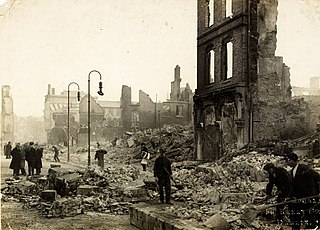
The burning of Cork by British forces took place on the night of 11–12 December 1920, during the Irish War of Independence. It followed an Irish Republican Army (IRA) ambush of a British Auxiliary patrol in the city, which wounded twelve Auxiliaries, one fatally. In retaliation, the Auxiliaries, Black and Tans and British soldiers burned homes near the ambush site, before looting and burning numerous buildings in the centre of Cork, Ireland's third-biggest city. Many Irish civilians reported being beaten, shot at, and robbed by British forces. Firefighters testified that British forces hindered their attempts to tackle the blazes by intimidation, cutting their hoses and shooting at them. Two unarmed IRA volunteers were also shot dead at their home in the north of the city.
The 3rd Cork Brigade, also known as Third (West) Cork Brigade, was a unit of the Irish Republican Army that operated in the western areas of County Cork during the Irish War of Independence. The unit was commanded by Tom Barry for most of the conflict and was responsible for the Kilmichael Ambush and Crossbarry Ambush. Charlie Hurley took command of the brigade during Tom Barry's illness in 1920.
The Tooreen ambush was an ambush carried out by the Irish Republican Army (IRA) on 22 October 1920, during the Irish War of Independence. It took place near Roberts Farm, Tooreen, near Ballinhassig in County Cork. The IRA ambushed two lorries of British soldiers, killing three and wounding four others. The British surrendered and their weapons and ammunition were seized by the IRA. Later that night, British soldiers went on a rampage in nearby Bandon.
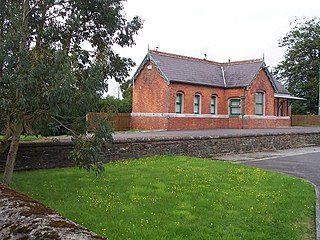
The Upton train ambush took place on 15 February 1921, during the Irish War of Independence. The Irish Republican Army (IRA) mounted an attack on a train carrying British soldiers at Upton, County Cork. The action was a disaster for the IRA; three of its volunteers were killed, two wounded and one captured. Six British soldiers were wounded, three seriously. At least eight civilian passengers were killed and ten wounded in the crossfire.
The destruction of country houses in Ireland was a phenomenon of the Irish revolutionary period (1919–1923), which saw at least 275 country houses deliberately burned down, blown up, or otherwise destroyed by the Irish Republican Army (IRA). The vast majority of the houses, known in Ireland as big houses, belonged to the Anglo-Irish upper class known as the Protestant Ascendancy. The houses of some Roman Catholic unionists, suspected informers, and members or supporters of the new Irish Free State government were also targeted. Although the practice by the IRA of destroying country houses began in the Irish War of Independence, most of the buildings were destroyed during the Irish Civil War (1922–23). Today, most of the targeted buildings are in ruins or have been demolished. Some were restored by their owners, albeit often smaller in size, or were later rebuilt and re-purposed.

The sack of Balbriggan took place on the night of 20 September 1920, during the Irish War of Independence. Auxiliary members of the Royal Irish Constabulary known as "Black and Tans" went on a rampage in the small town of Balbriggan, County Dublin, burning more than fifty homes and businesses, looting, and killing two local men. Many locals were left jobless and homeless. The attack was claimed to be revenge for the shooting of two police officers in Balbriggan by the Irish Republican Army (IRA). It was the first major 'reprisal' attack against an Irish town during the conflict. The sack of Balbriggan drew international attention, leading to heated debate in the British parliament and criticism of British government policy in Ireland.

Thomas (Tom) Deignan was a Commandant of the Irish Republican Army in the Irish War of Independence, politician and veteran of World War I. He fought on the Anti-Treaty side in the Irish Civil War. After the war he entered local politics until his death.
following the Ballinhassig ambush Further extensive damage was done [..] Mr. Joseph Brennan's private residence, Kilbrogan House, was then attacked by soldiers [..] Joseph Brennan, the son of the owner of Kilbrogan House, is private secretary to Sir John Anderson, one of the Irish Under-Secretaries
A glaring example of the carelessness of the unruly soldiers was their attack on Kilbrogan House, where the prosperous and well-connected occupant was Joseph Brennan
We fell in love with this wonderful georgian town house in the early 1990s and have spent many years restoring it
This location is no longer in operation